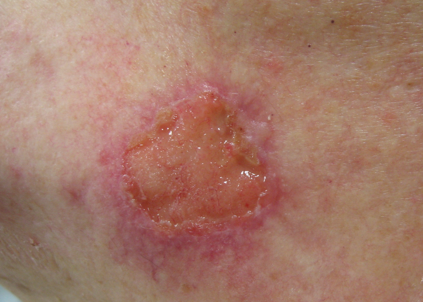What does skin cancer look like?
Skin cancer generally stands out as being different to surrounding skin. If a spot strikes you as being a bit odd, take it seriously.
Skin cancer mostly appears as a new and unusual looking spot. It may also appear as an existing spot that has changed in colour, size or shape.
How does skin cancer develop?
Skin cancer develops when the cells of the skin are damaged. This causes cells to mutate, reproduce abnormally and form a mass of cancerous cells. The type of skin cancer that develops depends on the type of cells that are involved.
Damage to the skin cells’ DNA leads to the cells mutating. This damage can be caused by ultraviolet radiation from sunlight and from tanning beds.
Other factors may also contribute to the development of skin cancer since it can develop on parts of the body that are not normally exposed to these sources of ultraviolet light. Exposure to toxic substances or having a weakened immune system may also contribute to the development of skin cancer.
How does skin cancer spread?
Whether and how skin cancers spread depends on the type of skin cancer. Basal cell carcinomas and squamous cell cancers rarely spread. Melanomas are the most likely type of skin cancer to spread and metastasise. Melanoma can spread to any part of the body, but the most common areas it spreads to are the lungs, liver, bones, brain, abdomen and lymph nodes.
Basal cell carcinoma
Of the more than 3 million cases of skin cancer diagnosed every year, more than 80 percent are basal cell carcinoma, according to the American Cancer Society. These cancers develop within the basal cell layer of the skin, the lowest part of the epidermis.
This type of skin cancer tends to occur in areas of the skin that receive the most exposure to the sun, like the head and neck. Basal cell cancers usually grow slowly, and it is rare for them to spread, or metastasize, to nearby lymph nodes or even to more distant parts of the body. But this may occur if it is left untreated, so early detection and treatment are important.
Basal cell cancers may also recur in the same location where the original cancer formed. Patients who have had basal cell carcinoma once have an increased risk of developing a new basal cell cancer elsewhere. As many as 50 percent of these patients may develop a new basal cell carcinoma within five years of their first diagnosis.
Squamous cell carcinoma
The second most common form of skin cancer Squamous Cell carcinoma(SCC). It may grow much faster than a BCC. SCC’s may occasionally spread throughout the body (metastasize). SCCs usually form a scaly, quickly growing pink lump or wart-like growth, which may also break down, crust, bleed and ulcerate. They do not usually cause pain but may be tender, or cause a burning or stinging sensation. They most commonly occur on areas exposed to a lot of sunlight such as the face, ears, (bald) scalp, lips and backs of the hands.
People who have had organ transplants, or medications to suppress their immune system for other reasons, are at higher risk of developing SCCs. In transplant patients SCCs are also more likely to grow quickly and spread throughout the body. This makes regular skin checks and early treatment of skin cancers extremely important for people who have had transplants or have suppressed immune systems for other reasons.
Early detection allows simple local therapy such as excisional surgery, cryotherapy or electrosurgery. More extensive SCCs may require extensive surgery, lymph node removal and radiotherapy. Follow up post surgery is annually for low risk and every 3 months for 2 years for high risk SCCs.
Melanoma



Melanoma can grow quickly. It can become life-threatening in as little as six weeks and if untreated, it can spread to other parts of the body. It can appear on skin not normally exposed to the sun.
It is usually flat with an uneven smudgy outline, may be blotchy and more than one colour – brown, black, blue, red or grey.
Use the ABCD rule to look for melanoma where:
- A= asymmetry, look for spots that are asymmetrical not round
- B= border, look for spots with uneven borders
- C= colour, look for spots with an unusual or uneven colour
- D= diameter, look for spots that are larger than 7 mm
Treating skin Cancer
Treatment for skin cancer will depend on a number of factors:
- The type of skin cancer
- The size and location of the skin cancer
- Whether the skin cancer has spread (metastasized) to other parts of the body.
Treatment options can include:
- Surgical removal (excision) of the tumour and surrounding tissue.
- Curettage (scraping and burning).
- Cryotherapy with liquid nitrogen (commonly referred to as “˜freezing’).
- Radiotherapy (use of high energy rays such as X-rays to destroy cancer cells within a specific area).
- Photodynamic therapy – uses a light source and special cream to destroy cancer cells.
- Imiquimod – a cream that destroys skin cancer by stimulating the body’s immune system to fight the cancer.
- Chemotherapy is treatment with drugs, either pills or injections. It may be used to treat melanoma that has spread to other parts of the body.





